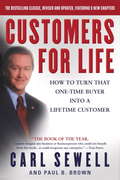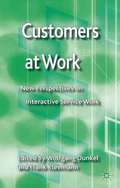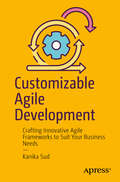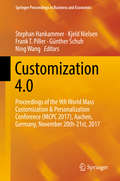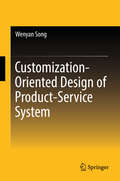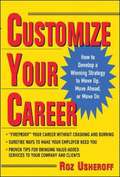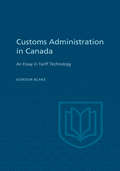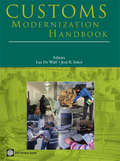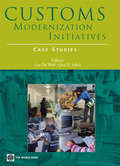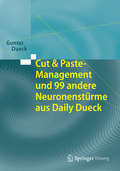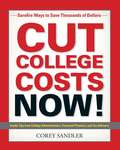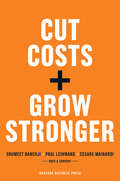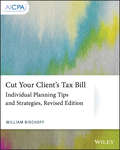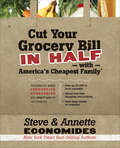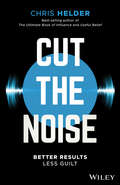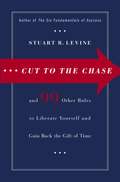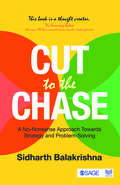- Table View
- List View
Customers For Life: How to Turn That One-Time Buyer Into a Lifetime Customer
by Carl Sewell Paul B. BrownSewell first revealed the secret of getting customers to return again and again in the original "Customers for Life. " A lively, down-to-earth narrative, it became a bestseller. Building on that solid foundation, this expanded edition features five new chapters, as well as significant additions to the original material, based on the lessons Sewell has learned over the last ten years. Copyright © Libri GmbH. All rights reserved.
Customers at Work
by Frank Kleemann Wolfgang DunkelExplores the ongoing transformation of service relationships, focusing on the incorporation of the customer's active contribution to virtually all aspects and stages of the production process. This volume illuminates social relations and interaction between customers and service providers as well as between the users of web-based services.
Customizable Agile Development: Crafting Innovative Agile Frameworks to Suit Your Business Needs
by Kanika SudThe one-size-fits-all approach to Agile project management doesn't always fit an organization's needs. This book seeks to highlight the importance of experimentation and customization in modern project management practices. In an era of digital transformation and rapid disruption, organizations must continuously strive to innovate and tailor their methodologies in order to thrive. You'll start by looking at key fundamentals and challenges, setting an agile mindset to then explore the basics of Agile, Scrum, Kanban, and Lean. Aided by practical examples and real-world case studies. you'll then move onto the more practical part of the book and can create customizable Agile frameworks using innovative practices and hybrid models to suit individual needs. With Customizable Agile Development as your guide, you'll be confident in how to adapt and create agile methodologies and frameworks that truly fit your requirements and needs. What You Will Learn Adapt Agile practices to their specific industry and context. Foster a culture of experimentation and continuous improvement. Create Agile frameworks that optimize efficiency and value delivery. Harness Agile methodologies to stay ahead in a rapidly changing world. Who This Book Is For Agile coaches and practitioners as well as product managers and strategy advisors
Customization 4.0: Proceedings of the 9th World Mass Customization & Personalization Conference (MCPC 2017), Aachen, Germany, November 20th-21st, 2017 (Springer Proceedings in Business and Economics)
by Günther Schuh Kjeld Nielsen Frank T. Piller Ning Wang Stephan HankammerThis proceedings volume presents the latest research from the worldwide mass customization & personalization (MCP) community bringing together new thoughts and results from various disciplines within the field. The chapters are based on papers from the MCPC 2017. The book showcases research and practice from authors that see MCP as an opportunity to extend or even revolutionize current business models. The current trends of Industrie 4.0, digital manufacturing, and the rise of smart products allow for a fresh perspective on MCP: Customization 4.0. The book places a new set of values in the centre of the debate: a world with finite resources, global population growth, and exacerbating climate change needs smart thinking to engage the most effective capabilities and resources. It discusses how Customization 4.0 fosters sustainable development and creates shared value for companies, customers, consumers, and the society as a whole. The chapters of this book are contributed by a wide range of specialists, offering cutting-edge research, as well as insightful advances in industrial practice in key areas. The MCPC 2017 has a strong focus on real life MCP applications, and this proceedings volume reflects this. MCP strategies aim to profit from the fact that people are different. Their objective is to turn customer heterogeneities into opportunities, hence addressing “long tail” business models. The objective of MCP is to provide goods and services that best serve individual customers’ needs with near mass production efficiency. This proceedings volume highlights the interdisciplinary work of thought leaders, technology developers, and researchers with corporate entrepreneurs putting these strategies into practice.Chapter 24 is open access under a CC BY 4.0 license via link.springer.com.
Customization-Oriented Design of Product-Service System
by Wenyan SongThis book is devoted to the customization design of product/service system (PSS), making use of a systematic design process and a number of methods, especially Industrial Customer Activity Cycle Analysis, Service Quality Function Deployment, Service Function and Attribute Analysis, Modified Service Blueprint, Multi-Objective Optimization and Multi-Criteria Recommendation Method. The book is especially valuable in manipulating the problems of PSS requirements analysis, design conflict, design reuse and proactively response to customer. The methods in the book facilitate modular design of customized solutions and enhance PSS design efficiency. Presenting case studies, this book helps researchers and practitioners to understand the customization process and methods in the early development of PSS.
Customize Your Career: How To Develop A Winning Strategy To Move Up, Move Ahead, Or Move On
by Roz Usheroff<p>Techniques and strategies for professionals to bolster their job security by becoming a more valuable employee <p>Today's smartest employees know that, to keep themselves from the "firing" line, they must constantly increase their value to their employers, customers, and clients. <i>Customize Your Career</i> presents readers with a twostep process for becoming an indispensable employee, by first defining one's personal mission and then using that mission as a blueprint to develop a professional success strategy. <p>High-profile career builder Roz Usheroff has made her name by showing business professionals how to discover and develop their own intellectual property, even in uncertain and insecure economic climates. Here, she provides solid, workplace-proven strategies designed to help anyone: <p> <li>Enhance interpersonal and communication skills <li>Become recognized as a leader and change-agent <li>Master the finer points of business protocol</li> </p>
Customizing Global Marketing
by John A. Quelch Edward J. HoffThe big issue for multinationals today is not whether to go global but how to tailor the global marketing concept to fit each business. In determining the degree of standardization or adaptation that is appropriate, managers should consider their companies' overall business strategy, which products will benefit from the economies or efficiencies of standardization, which products won't fight cultural barriers, what trade-offs will result from standardizing various elements of the marketing mix, and how standardization will vary from country to country.
Customizing Your Strategy Map to Your Strategy
by Robert S. Kaplan David P. NortonA well-constructed strategy map should show the interrelationships among the organization's internal processes and intangible assets that create sustainable competitive advantage. The value proposition in the customer perspective, the critical internal processes, and the intangible assets in the learning and growth perspective of a strategy map will be completely different for companies following different strategies. While every organization must adapt and customize its strategy map to its unique situation, in this chapter the authors sketch templates for four generic strategies: low cost, product leadership, customer solutions, and system lock-in.
Customs Administration in Canada
by Gordon BlakeThe Canadian tariff has been a singularly faithful mirror of economic and political change in this country, but it is a glass through which much has been seen darkly. This study is an attempt to improve the view. It traces the administration of the tariff through Canadian history, and provides the first complete treatment of the subject and its significance for the country's commerce.Dr. Blake's work begins with customs administration during the French régime, and follows with the British period---the struggle for responsible government, the problem of smuggling, and the establishment of free ports. The author discusses such early problems as customs union in the Canadas, reciprocity and the Galt tariff, and ad valorem duties and their administrative consequences. Confederation and its effect on customs administration are analysed, as are the tariff schedule up to modern times, valuation and the effects of war, and the system and problems of appraisement. The customs establishment since Confederation is studied under such heads as organization, problems of adjustment, and political patronage in the service. Finally, the Canadian Tariff Board is put under examination.This study does not constitute an argument on either side of the policy controversy as regards free trade or protection nor is it a linearly historical treatment of Canadian commercial policy. It is an attempt to fit into the Canadian environment certain more or less theoretical concepts which may serve to explain the tariff as an important economic institution. It will be of interest to students of Canadian economic history, particularly in the area of national revenue.
Customs Modernization Handbook
by Jose B. Sokol Luc De WulfTrade integration contributes substantially to economic development and poverty alleviation. In recent years much progress was made to liberalize the trade regime, but customs procedures are often still complex, costly and non-transparent. This situation leads to misallocation of resources. 'Customs Modernization Handbook' provides an overview of the key elements of a successful customs modernization strategy and draws lessons from a number of successful customs reforms as well as from customs reform projects that have been undertaken by the World Bank. It describes a number of key import procedures, that have proved particularly troublesome for customs administrations and traders, and provides practical guidelines to enhance their efficiency. The Handbook also reviews the appropriate legal framework for customs operations as well as strategies to combat corruption.
Customs Modernization Initiatives
by Jose B. Sokol Luc De WulfA companion to the 'Customs Modernization Handbook', this book provides case studies on customs modernization initiatives in seven countries: Bolivia, Morocco, Mozambique, Peru, the Philippines, Turkey, and Uganda. The initiatives in each of these countries show similarities as well as differences in their approach and design. Some have relied on a model of independent revenue authorities (Uganda and Peru), others have called upon private sector service providers to initiate the modernization process (Mozambique), others have taken the drastic step of a complete overhaul of their customs staff (Bolivia and Mozambique), others introduced new information technology to streamline customs processes and to integrate other members of the trading community into an electronic network (Ghana), while still others have approached the modernization process as a pragmatic, well-focused, result-oriented process.
Cut & Paste-Management und 99 andere Neuronenstürme aus Daily Dueck
by Gunter DueckSeit 2005 schreibt der Bestsellerautor Gunter Dueck auf seiner Hompepage alle 14 Tage ein neues "Daily Dueck". Mehr als inzwischen 10. 000 Stammleser finden dort Satirisches, Ergötzliches oder auch herb Kritisches. Dieser Band enthält als "zweite Staffel" die "Daily Duecks" Nummer 100 bis 199 für diejenigen, die lieber ein Buch in den Händen halten oder versäumtes Lesen nachholen möchten. Hier finden Sie viel satirisch-ätzende Managementkritik, Aufrufe zu mehr Bildung und Innovation, politische Grundsatzkommentare bis hin zu Ärger über die NSA. (Die ersten 99 Daily Duecks erschienen unter dem Titel "Platons grotesker Irrtum". )
Cut College Costs Now!
by Corey SandlerDrawing on insider advice from a roundtable of college administrators and financial planners, Cut College Costs NOW! shows you the best ways to manage spending, apply for financial aid, and increase your eligibility for federal, state, and private funding.
Cut College Costs Now!
by Corey SandlerDrawing on insider advice from a roundtable of college administrators and financial planners, Cut College Costs NOW! shows you the best ways to manage spending, apply for financial aid, and increase your eligibility for federal, state, and private funding. Also included is a line-by-line analysis of the two most important financial aid forms--the FAFSA application and the CSS/Profile. This comprehensive guide gives advance planning strategies for structuring finances before college application -- as well as how to restructure investments once the college bills start to arrive. Cut College Costs NOW! is the real deal on how to be a savvy college consumer. Corey Sandler is the author of the bestselling Performance Appraisal Phrasebook and has written more than 150 books on business and other topics.
Cut College Costs Now!: Surefire Ways to Save Thousands of Dollars
by Corey SandlerA Simon & Schuster eBook. Simon & Schuster has a great book for every reader.
Cut Costs, Grow Stronger: A Strategic Approach to What to Cut and What to Keep
by Paul Leinwand Cesare R. MainardiFor most companies, cost cutting in a down economy means across-the-board slashing that "spreads the pain" of budget reductions across many departments. While that may sound like the best approach for getting critical results fast and for limiting political infighting, it is a mistake-one that will leave your company weaker, not just smaller. Instead, companies that need to reduce costs should treat the challenge as an opportunity to identify and reinforce their key capabilities, while divesting from those activities that do not truly reflect the business's strengths or long-term goals. This more strategic approach will make your company more resilient as tough times continue and more robust as recovery begins.In Cut Costs, Grow Stronger, an e-book published as part of the Harvard Business Press Memo to the CEO series, Booz & Company's Shumeet Banerji, Paul Leinwand and Cesare Mainardi provide executives with the tools they need to rapidly implement capabilities-driven cost reduction. First they demonstrate how to identify and clearly articulate your company's key capabilities-not just core competencies or skill sets, but those very few strengths that, in combination, define how your organization competes. You can then use this information to create your company's unique blueprint for effective and efficient cost reduction. The authors' detailed, step-by-step framework walks you through the process, which can be completed in as little as two or three months-it's something that you can do now. This practical guide to capabilities-driven cost-cutting is the tool executives need to confront the challenge of today's economy while strengthening the foundation for what will set their company apart in the future.
Cut Costs, Grow Stronger: A Strategic Approach to What to Cut and What to Keep
by Paul Leinwand Cesare R. MainardiFor most companies, cost cutting in a down economy means across-the-board slashing that "spreads the pain" of budget reductions across many departments. While that may sound like the best approach for getting critical results fast and for limiting political infighting, it is a mistake-one that will leave your company weaker, not just smaller. Instead, companies that need to reduce costs should treat the challenge as an opportunity to identify and reinforce their key capabilities, while divesting from those activities that do not truly reflect the business's strengths or long-term goals. This more strategic approach will make your company more resilient as tough times continue and more robust as recovery begins.In Cut Costs, Grow Stronger, an e-book published as part of the Harvard Business Press Memo to the CEO series, Booz & Company's Shumeet Banerji, Paul Leinwand and Cesare Mainardi provide executives with the tools they need to rapidly implement capabilities-driven cost reduction. First they demonstrate how to identify and clearly articulate your company's key capabilities-not just core competencies or skill sets, but those very few strengths that, in combination, define how your organization competes. You can then use this information to create your company's unique blueprint for effective and efficient cost reduction. The authors' detailed, step-by-step framework walks you through the process, which can be completed in as little as two or three months-it's something that you can do now. This practical guide to capabilities-driven cost-cutting is the tool executives need to confront the challenge of today's economy while strengthening the foundation for what will set their company apart in the future.
Cut Your Client's Tax Bill: Individual Planning Tips and Strategies (AICPA)
by William BischoffMany clients and businesses are highly focused on the impact of taxes and tax rates on their bottom line. President Trump and Congress's passage of the Tax Cuts and Jobs Act brought unhappy surprises to many taxpayers accustomed to getting tax refunds. Make sure your clients are protecting themselves from higher taxes. Completely updated for tax law changes and Tax Court decisions, this book will bring you up to date on the latest strategies that will preserve your clients' wealth and ensure your role as a trusted adviser to your clients. Get the latest techniques for building and conserving wealth through proactive tax-planning and investment strategies. Key topics covered include; Sales of capital gain assets and real property Planning for employer stock options, employer stock held in retirement accounts, and restricted stock Maximizing tax benefits for personal residence transactions Tax-planning opportunities with vacation homes, timeshares, and co-ownership arrangements Planning for divorce Tax-saving tips for self-employed clients Tax-smart college financing strategies
Cut Your Clients Tax Bill: Individual Tax Planning Tips and Strategies
by Bill BischoffCut Your Clients Tax Bill: Individual Tax Planning Tips and Strategies by Bill Bischoff
Cut Your Grocery Bill in Half with America's Cheapest Family: Includes So Many Innovative Strategies You Won't Have To Cut Coupons
by Annette Economides Steve EconomidesYou Can Save Thousands a Year on Your Grocery Bill Without Cutting CouponsImagine grocery shopping once-a-week or less, eating healthier, and having more free time—all while saving money. Sound too good to be true? For the Economides family, it’s a reality, and it can be yours too.What could the average family do with an extra $3,000 a year? America’s Cheapest Family® shows you strategies, tips, tools, and tricks in Cut Your Grocery Bill in Half, so you can achieve huge savings year after year. It’s a fact, the Economides say, saving money on groceries is one of the quickest ways to start making a positive difference in your family’s financial future. And these tips and strategies can work whether you’re shopping for seven or for one.Spend less time shopping and cookingGet more bang for your grocery buckPlan meals for picky eaters and busy schedulesDiscover kitchen tools that streamline meal preparationsLearn many ways to eat out or eat in and save bigTurn your freezer into a money-making machineEndorsements:"Many people think that it's impossible to reduce your grocery bill by 50%. But you can. Steve and Annette Economides provide step-by-step instructions in "Cut Your Grocery Bill in Half." Tools that are practical and easy to follow. No special shopping or cooking skills required. Anyone can see a surprising reduction in their grocery budget if they follow the Economides' methods. And, best of all, the savings begin right away. You don't need to finish the whole book to benefit. You'll find money-saving ideas that you can put to use in the first chapter, and every chapter thereafter. Normally I advise people to check books out of the library and save the cost of the book. But this is one do-it-yourself guide to lower grocery bills that you'll want to have on your bookshelf or kitchen countertop."Gary Foreman, Publisher, The DollarStretcher.com “If you are eager to save on groceries, but don't always have the time to clip coupons, this book is for you! It’s perfect if you're interested in more ways to cut costs, reduce waste, and get organized. This is an awesome book for the novice or the skilled cook.”Tawra Kellam and Jill Cooper—editors of LivingOnADime.com and authors of “Dining On A Dime Cookbook” “I've known Steve and Annette for several years and they definitely live what they believe. If you're serious about spending less money at the grocery store, this book offers some practical ways to achieve your goal. When it comes to stretching your dollar, I know of no one with more experience than Steve and Annette.”JJ Heller—Singer/Songwriter
Cut the Noise: Better Results, Less Guilt
by Chris HelderCut through the mental noise of modern life and move one step closer to true happiness The quest for perfection and the sheer volume of “noise” and guilt in modern life can be crushing on even the most put-together person. With Cut the Noise, author and popular keynote speaker Chris Helder will show you how to cut through the noise, release yourself from guilt and stop seeking perfection so that you can focus on what you really want and what really matters. Told through two fables, you'll learn how to cut out the things in your life that are not useful, deal with the obstacles that get in your way, prioritise what is really important and give yourself permission to make the most of every situation with less guilt. See the world in a new way and move closer to what you really want by embracing the book’s accessible principles Move beyond guilt by learning key concepts, including that most of what we worry about will never happen Clearly find out what is preventing your success so you can deal with it and focus on the things that truly matter Follow the book’s easy-to-read fable format and discover where to take your life from here For those who want to take back their lives from the constant noise and expectations of modern life, Cut the Noise is the important first step on the journey.
Cut to the Chase
by Stuart R. LevineHow can I get more done? How can I stay focused? How can I condense my workday so I have time to spend with the people I love?The answer to all these questions, according to bestselling author and business guru Stuart Levine, is to cut to the chase, and in his new book he's gathered together 100 concise, invaluable lessons to help you do just that. Cutting to the chase is about more than getting to the point; it's about staying focused, getting to grips with the job in hand and concentrating on what's i...
Cut to the Chase: A No-Nonsense Approach Towards Strategy and Problem Solving
by Sidharth BalakrishnaThe book covers important aspects of Devising Successful Strategies and implementing Innovation through novel concepts and approaches. It stresses on a practical approach based on the author’s learnings from Heading Corporate Strategy at large Indian conglomerates such as the Vedanta and the Essel (Zee) Groups. It covers important new management concepts or a new ways of looking at existing concepts giving many actual examples and illustrations which both mid-and senior level professionals would associate with. The emphasis throughout is on practical challenges and examples relevant to the Indian context, outlining approaches which executives in various companies can adopt to ensure they are more successful and effective in their work.
Cutter & Buck (A)
by William A. Sahlman Victoria W. WinstonOnly three short months into her new position as CEO of publicly traded golf apparel manufacturer Cutter & Buck, Fran Conley discovers accounting irregularities that call into question the reliability of this company's financial statements. Working closely with her board of directors, Conley must figure out what is really going on. She must also deal with the possibility of SEC sanctions, class action lawsuits, threat of NASDAQ delisting, loss of D&O insurance, departure of senior managers, and problems with access to credit. She is also trying to turn the company around after two years of poor performance.
Cutter & Buck (A)
by William A. Sahlman Victoria W. WinstonOnly three short months into her new position as CEO of publicly traded golf apparel manufacturer Cutter & Buck, Fran Conley discovers accounting irregularities that call into question the reliability of this company's financial statements. Working closely with her board of directors, Conley must figure out what is really going on. She must also deal with the possibility of SEC sanctions, class action lawsuits, threat of NASDAQ delisting, loss of D&O insurance, departure of senior managers, and problems with access to credit. She is also trying to turn the company around after two years of poor performance.
